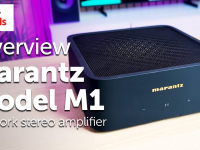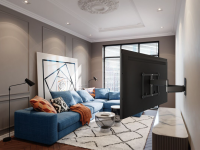Those familiar with the words of that venerable sage Alan Partridge, will no doubt remember the utterance ‘It’s like people who say Tannoy when they mean “public address system”. Tannoy is a brand name.’ So synonymous is the company with the loudspeaker systems used for public address (PA) – dating all the way back to the Second World War – that the two are nearly inseparable.
With a history that stretches all the way back to 1926, the company, originally founded in London (now based in Scotland), has been one of the foremost home-loudspeaker manufacturers in the world ever since. Over the years they’ve been responsible for numerous innovations in their field – chiefly their ‘dual concentric’ drivers that situate the tweeter in the ‘throat of the principal drive unit.
Tannoy’s current top of the range model – the Westminster GR – has a retail price just shy of £28,000. Fortunately for us they’ve also got a few slightly keener priced ranges, too!
The subject of today’s review is the Precision range, namely the ‘6.4‘. One of two available floorstanding speakers (the 6.2 is the other), the range also consists of two pairs of bookshelf speakers for those with space at a premium. One tier up from the multi-award winning ‘Revolution‘ series, they build on the cheaper series’ already excellent reputation and add a few of their own tricks, to boot.
Taking these substantial beasts out of their boxes is much easier with another set of hands, as each speaker comes in at a whopping 21kg. Once out of their packaging, a few minutes of minor manual labour are required to fix the pedestal bases and spikes to each speaker. The necessary tools are supplied, and it was a pain-free process. They’re definitely a lovely looking speaker – the ‘Satin Walnut’ cabinet of our review pair were beautifully presented, but a high-gloss finish is available at a premium for those that aren’t after a wood effect. The speakers curved sides are both a design feature and sound enhancer, built as they are to stop standing waves created by the bass drivers.
Getting down to the technical side, the 6.4 houses a 150mm (6”) concentric drive unit for mid and high frequency response, and a matching bass driver further down into the cabinet for low frequency extension. Two Auxiliary Bass Radiators (ABR) are sat one-above and one-below this main driver. These ABR’s are not wired back to the crossover as with the other drivers, but merely sit inside the same chamber as the main driver, helping to create bass extension from the resonance created by air moving inside the cabinet. Using ABR’s means that a bass port is not featured, so positioning is easier, at the expense of less ‘bloom’ to the lower end. Recommended power input is 20-100 watts, and the speakers are a fair 90db sensitivity, meaning you won’t need huge amounts of power to drive them. That being said, as with most speakers, they benefited from larger amounts of power than smaller.
Deserving of it’s own small paragraph is the grounding terminal that has been added to the speaker output connection plate on the back. Standard bi-wiring terminals are supplied, but a fifth connection is fitted just above these, and is designed to run back to your amplifier in order to give the speaker better earthing. The 6.4 were tried both with and without this extra wiring in place, and the benefits were seen as substantial enough to leave the cable in for the remainder of listening.
The Roksan Caspian M2 and the Cambridge Audio 851A were picked for listening, and we stuck with the latter after a bit of messing around seeing what worked best.
The speakers were given a full two days running in, and they definitely benefited from this. Sounding hard and cold from the box, they mellowed out at the top end, and bass was much better extended after this bedding in period.
After their total and utter domination of 2013 with their Pharrell Williams-featuring ‘Get Lucky‘, it’s easy to forget that Daft Punk made their name as young, French House and Techno producers. Their earlier work is so far removed from their current material as to almost sound like different artists all together. Case in point is live rarity ‘Alive 1997‘. Recorded in Birmingham in, you guessed it, 1997, the album is a 45 minute excerpt of the Gallic duo playing cuts from their first album ‘Homework‘. The songs are mixed and produced live, and are a great deal more intense than their original versions. Through the Tannoy‘s, the music was sheer exhilaration. The pace and tenacity of the album was thrown right into the room at full speed, and the tight and fast bass kept everything on a knife edge. I’ve always had a preference for accurate bass with little overhang, but some may find this to sound a tad bass-shy. It’d be for the listener to decide, but here I found it perfect for the music at hand. The volume was pushed WAY higher than it should have been, but the Tannoy never flinched. A great start!
Aiming for something a smidge mellower (which wasn’t difficult!), Tears for Fears excellent ‘Songs from the Big Chair‘ was next up. Given the (in my humble opinion!) terrible recording standards of producers and engineers in the 80s, it is a credit to the band and the producer that this album still holds up as brilliantly mixed even today. The album spawned a number of hit singles upon release in 1985 (the year I was born!), and the songs popularity even now is a testament to their quality. Superb pop melodies, fantastic musicianship, need I say more! ‘Everybody Wants to Rule the World‘ sounded glorious, its shimmering, fanciful chords bringing a touch of summer into our chilly, winter demo room. ‘Head Over Heels’ equally was a joy to listen to, and again I felt that the bass was solid whilst not desperate to hang about. Some of my colleagues were less inclined to agree with me on this, but they were still smiling away regardless!
In summary, these latest Tannoy’s are a touch of class, offering a clear and detailed sound without sounding harsh. The tried-and-tested Dual Concentric drivers sounded refined with vocals, and the bass drive units offered punch and pace to the lower frequencies. Their lack of super-deep extension means that a demo is a must, but for the right listener these are a heck of a speaker.
Author: Chris, Liverpool store
Contact your local Richer Sounds store to arrange a demo.








